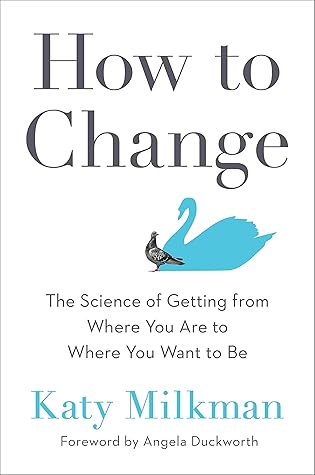More on this book
Community
Kindle Notes & Highlights
Hengchen began digging into existing research on how people think about special dates such as New Year’s, and she came back with an intriguing discovery. Her search led her to a literature in psychology on how people think about the passage of time. She learned that rather than perceiving time as a continuum, we tend to think about our lives in “episodes,” creating story arcs from the notable incidents, or chapters, in our lives. One chapter might start the day you move into your college dorm (“the college years”), another with your first job (“the consulting era”), another on your fortieth
...more
An ideal time to consider pursuing change is after a fresh start.
Fresh starts increase your motivation to change because they give you either a real clean slate or the impression of one; they relegate your failures more cleanly to the past; and they boost your optimism about the future. They can also disrupt bad habits and lead you to think bigger picture about your life.
Fresh starts can be calendar dates that mark new beginnings (a new year, season, month, or week), birthdays, or anniversaries. They can also be triggered by meaningful life events, such as a health scare or a move to a new town. And finally, resets—when the metrics you’re using t...
This highlight has been truncated due to consecutive passage length restrictions.
Although fresh starts can jolt you into positive change, they can also interrupt you when you’re on a roll, rev...
This highlight has been truncated due to consecutive passage length restrictions.
A particularly effective time to encourage other people—employees, friends, or family members—to pursue positi...
This highlight has been truncated due to consecutive passage length restrictions.
Much to the surprise of many teachers who feared it would be distracting, when students were given the opportunity to enjoy snacks, music, and Magic Markers while working on challenging math worksheets, they got more of their assignment done.
Gamification is unhelpful and can even be harmful if people feel that their employer is forcing them to participate in “mandatory fun.”
We just need to “flip the script” so that instant gratification is working for us, not against us. Research has proven time and again that rather than relying on willpower to resist temptation, we’re better off figuring out how to make good behaviors more gratifying in the short-term.
Present bias (a.k.a. impulsivity)—the tendency to favor instantly gratifying temptations over larger long-term rewards—is a pernicious obstacle to change.
Mary Poppins has it right. When goal pursuit is made instantly gratifying by adding “an element of fun,” present bias can be overcome.
Temptation bundling entails allowing yourself to engage in a guilty pleasure (such as binge-watching TV) only when pursuing a virtuous or valuable activity...
This highlight has been truncated due to consecutive passage length restrictions.
Temptation bundling solves two problems at once. It can help reduce overindulgence in temptations and increase time spent on activi...
This highlight has been truncated due to consecutive passage length restrictions.
Gamification is another way to make goal pursuit instantly gratifying. It involves making something that isn’t a game feel more engaging and less monotonous by adding gamelike features such as symbo...
This highlight has been truncated due to consecutive passage length restrictions.
Gamification works when players “buy in” to the game. It can backfire if players feel the gam...
This highlight has been truncated due to consecutive passage length restrictions.
Making smaller, more frequent commitments is more effective than making larger, less frequent ones, even when they amount to the same commitment (like saving 5 dollars a day as opposed to 1,825 dollars a year).
Not everyone recognizes how much they could benefit from a commitment device. Those who don’t (“naïfs”) tend to overestimate their ability to avoid temptation with willpower alone. Those who do (“sophisticates”) are better positioned to make change in their lives.
Students who had approached their goals in the typical way had a measly 22 percent success rate, while those who had made just a little tweak to the standard approach reported a whopping 62 percent success rate. So what was the tweak? It was something the study’s author—renowned New York University psychology professor Peter Gollwitzer—calls forming an “implementation intention.” This fancy term actually refers to a fairly straightforward strategy the group of students with the higher success rate used: making a plan for achieving a goal and linking it to a specific cue that will remind you to
...more
This highlight has been truncated due to consecutive passage length restrictions.
Understanding what gives us the confidence to push forward in the face of discouragement, and how we can instill that confidence in other people, can be important for anyone hoping to change and help others do the same.
On the day of the experiment, shortly after the start of a new school term, nearly two thousand students across seven Florida high schools walked into a computer lab with their teachers. Some simply filled out a few short digital questionnaires. But others were invited to do something quite out of the ordinary. All their lives, these students, like all students, had been given advice in school—“stay focused in class,” “do more practice problems before tests,” and “always turn your homework in on time.” Today would be different. This time, they were being asked for their advice. This lucky
...more
This highlight has been truncated due to consecutive passage length restrictions.
Max had insisted that there wasn’t anything special about him that helped his students succeed. It was something special about his students. When I emailed asking for his mentoring secrets, he’d explained that his students ranged “from very smart to spectacular.” His unshakable faith that each student he advised had remarkable talents, I now realized, was a bedrock of Max’s advising success.
Study after study (mine included) has shown that achieving transformative behavior change is more like treating a chronic disease than curing a rash.


